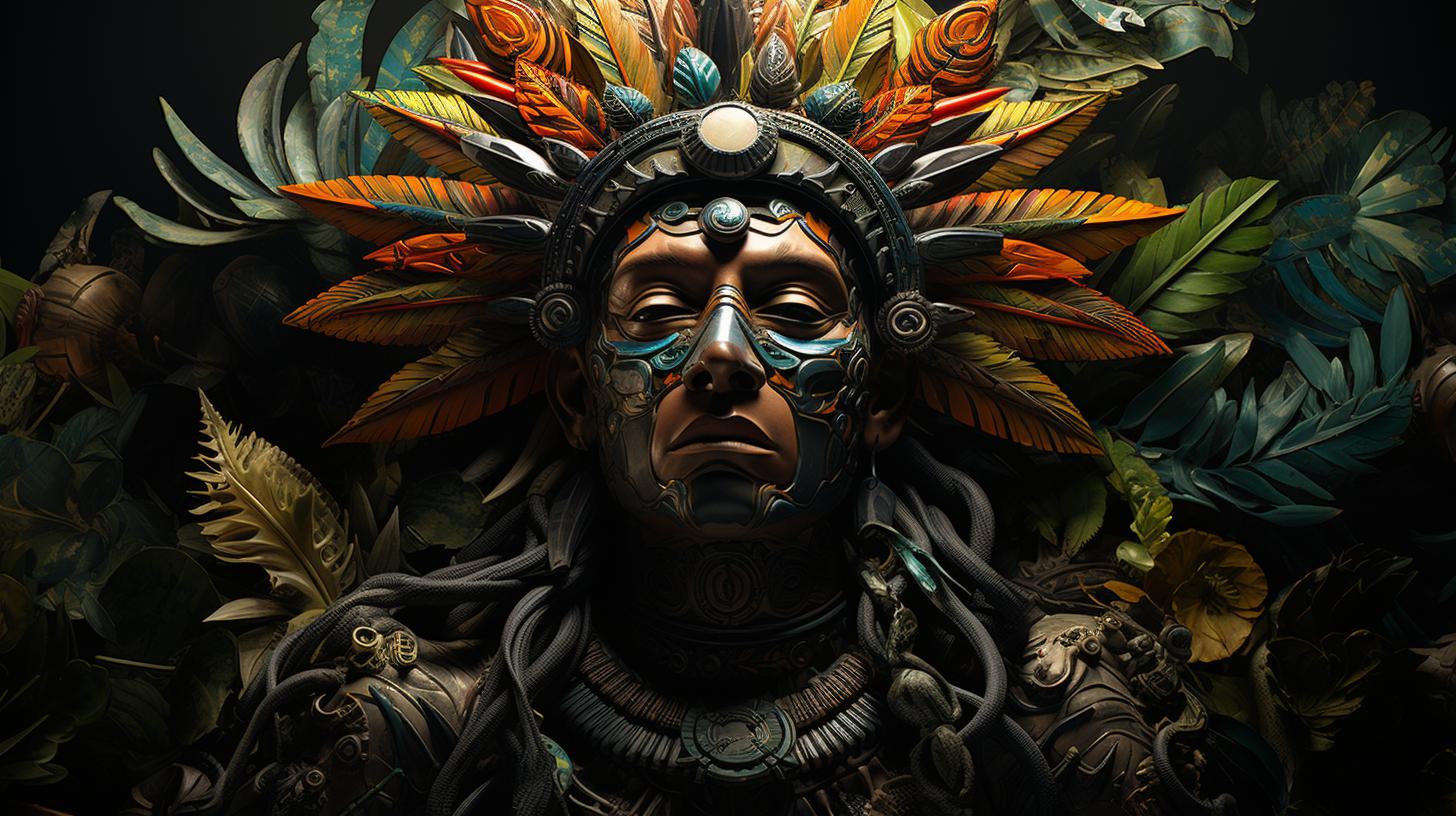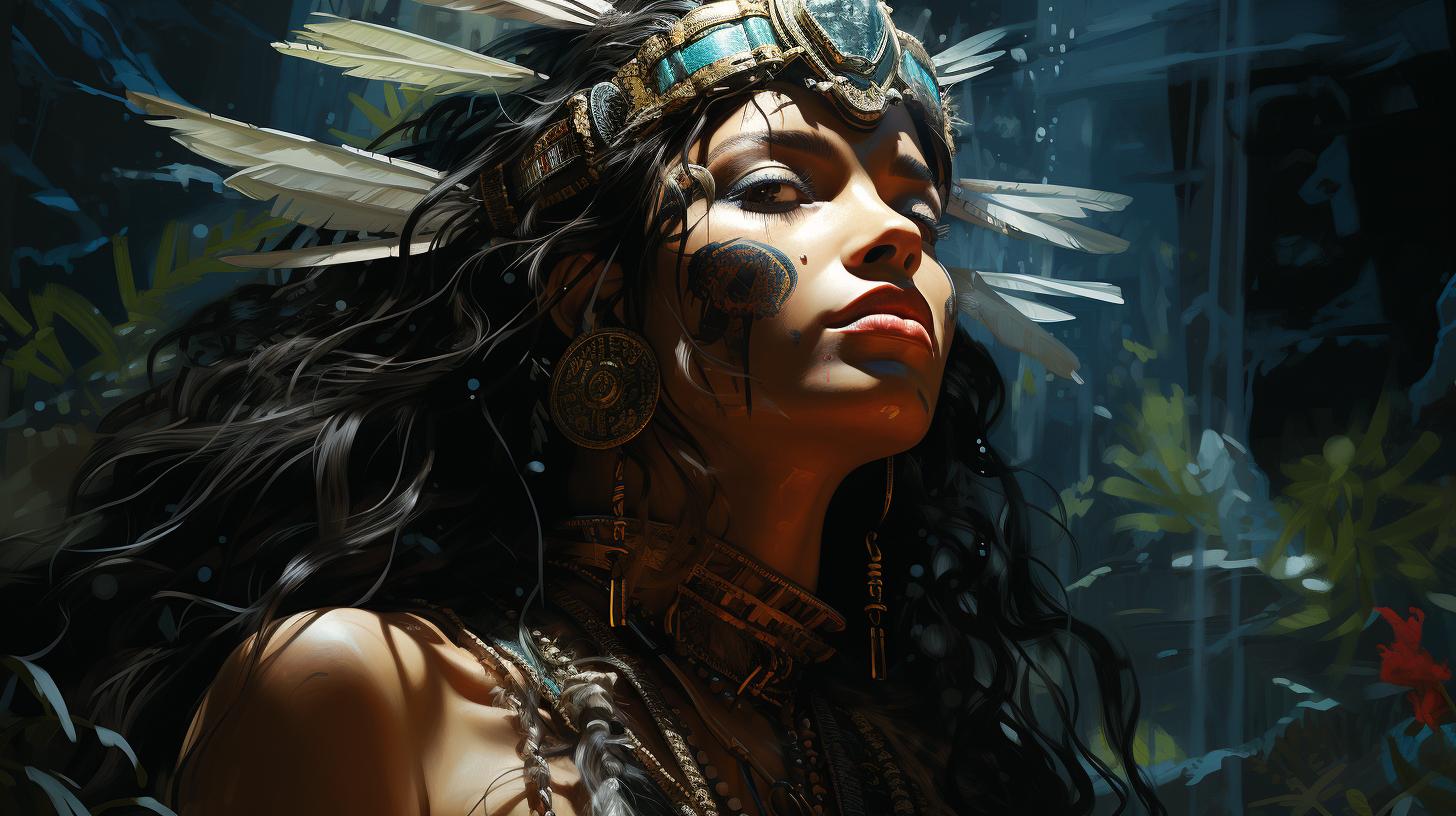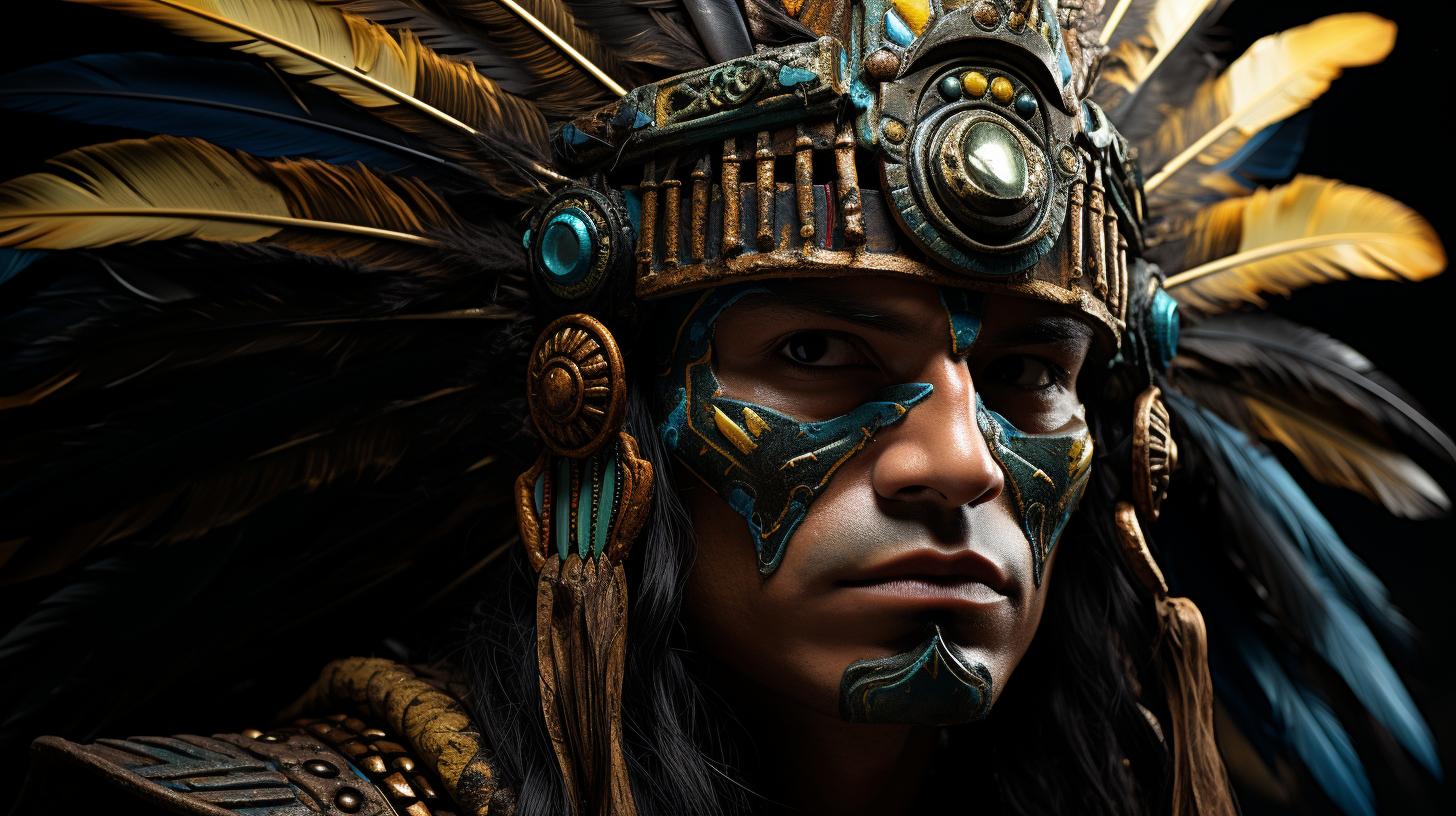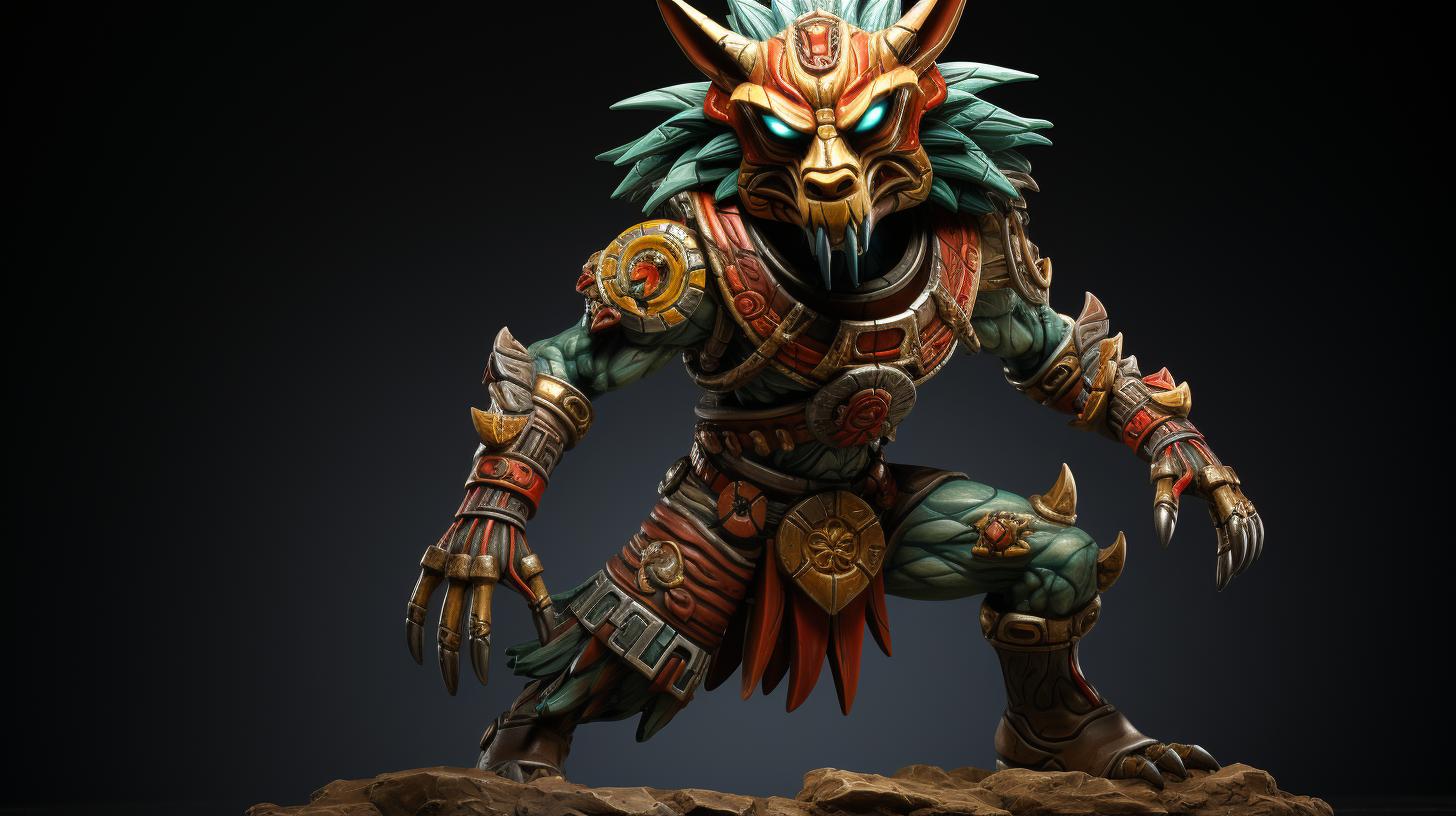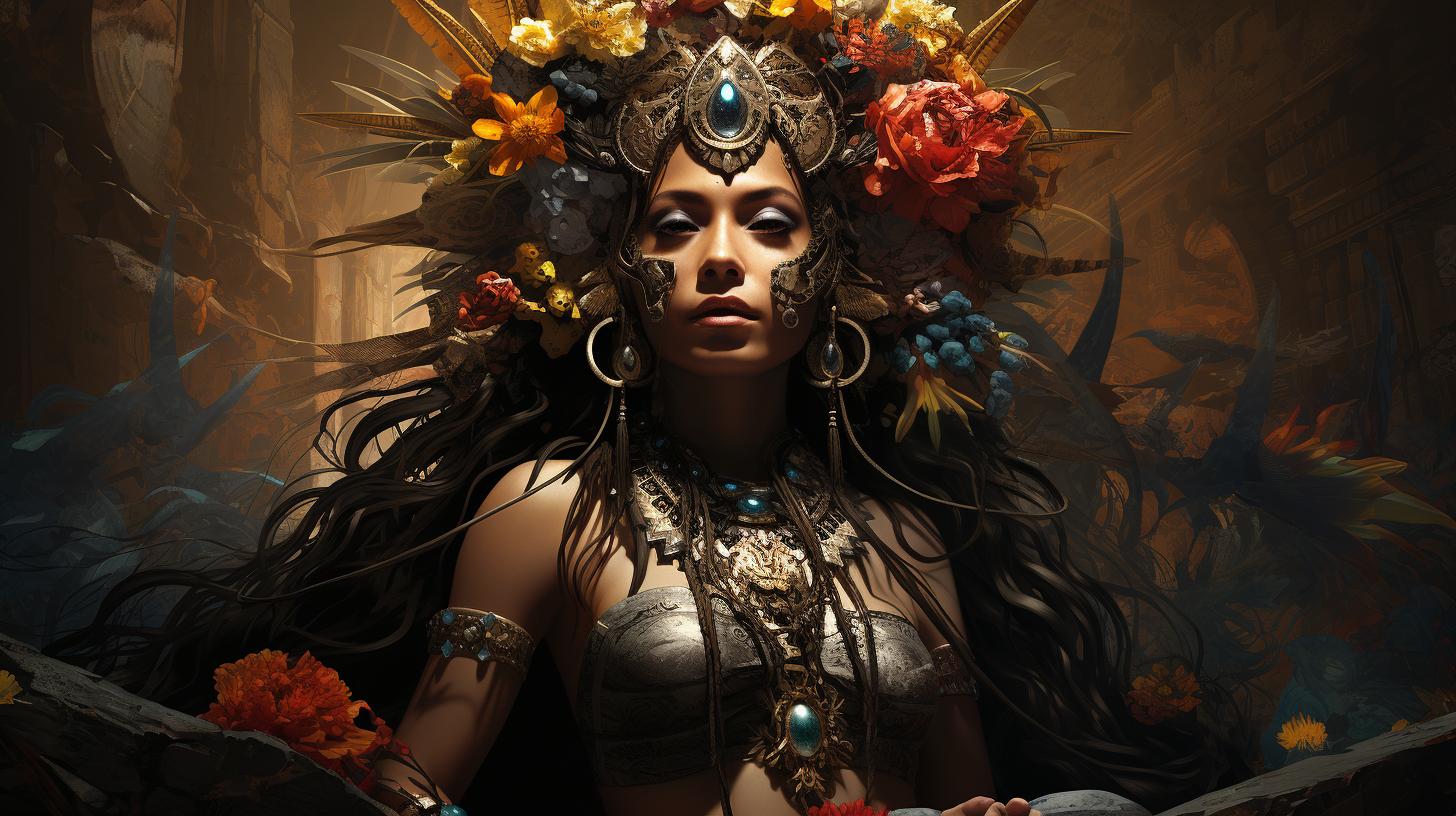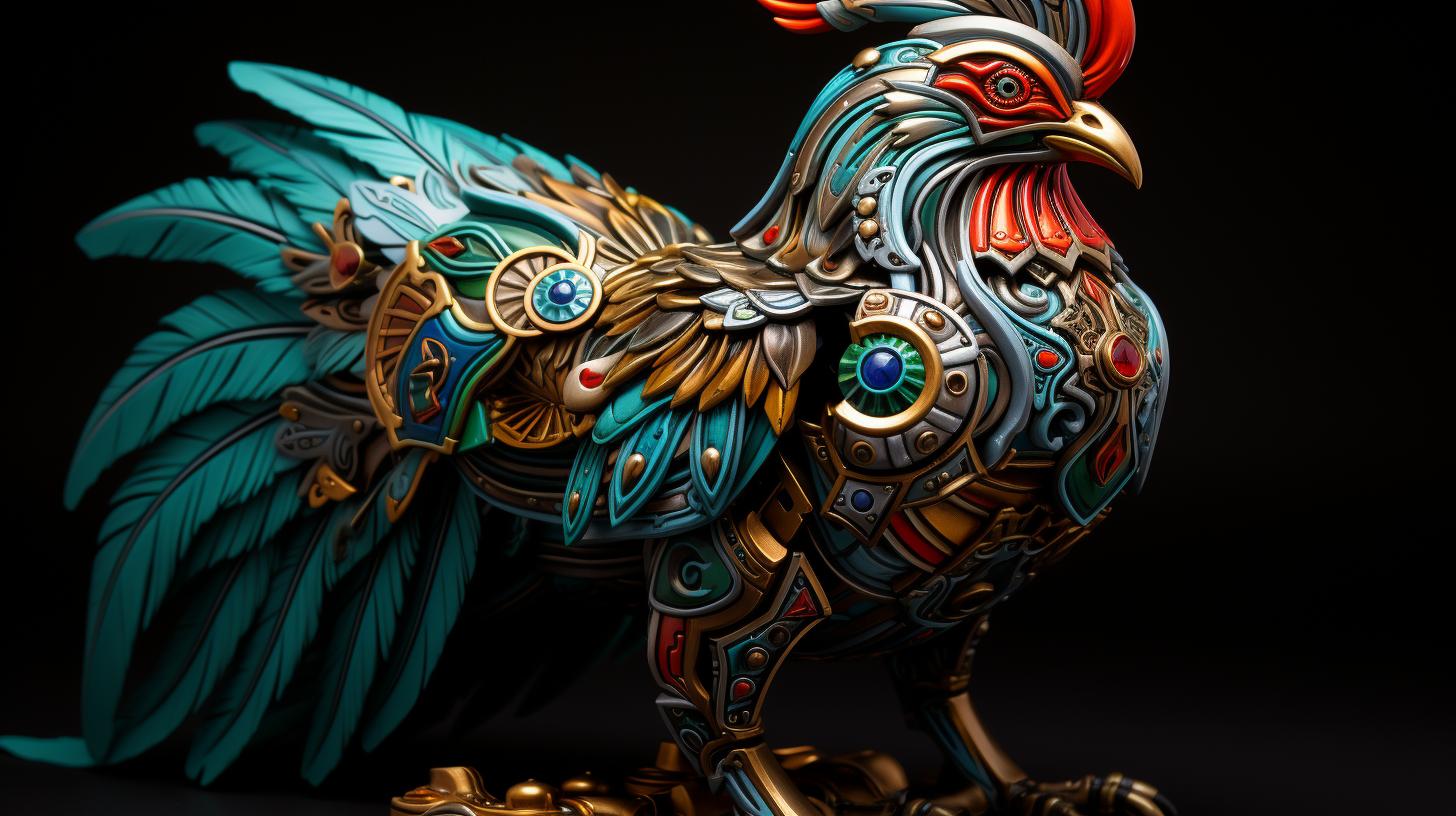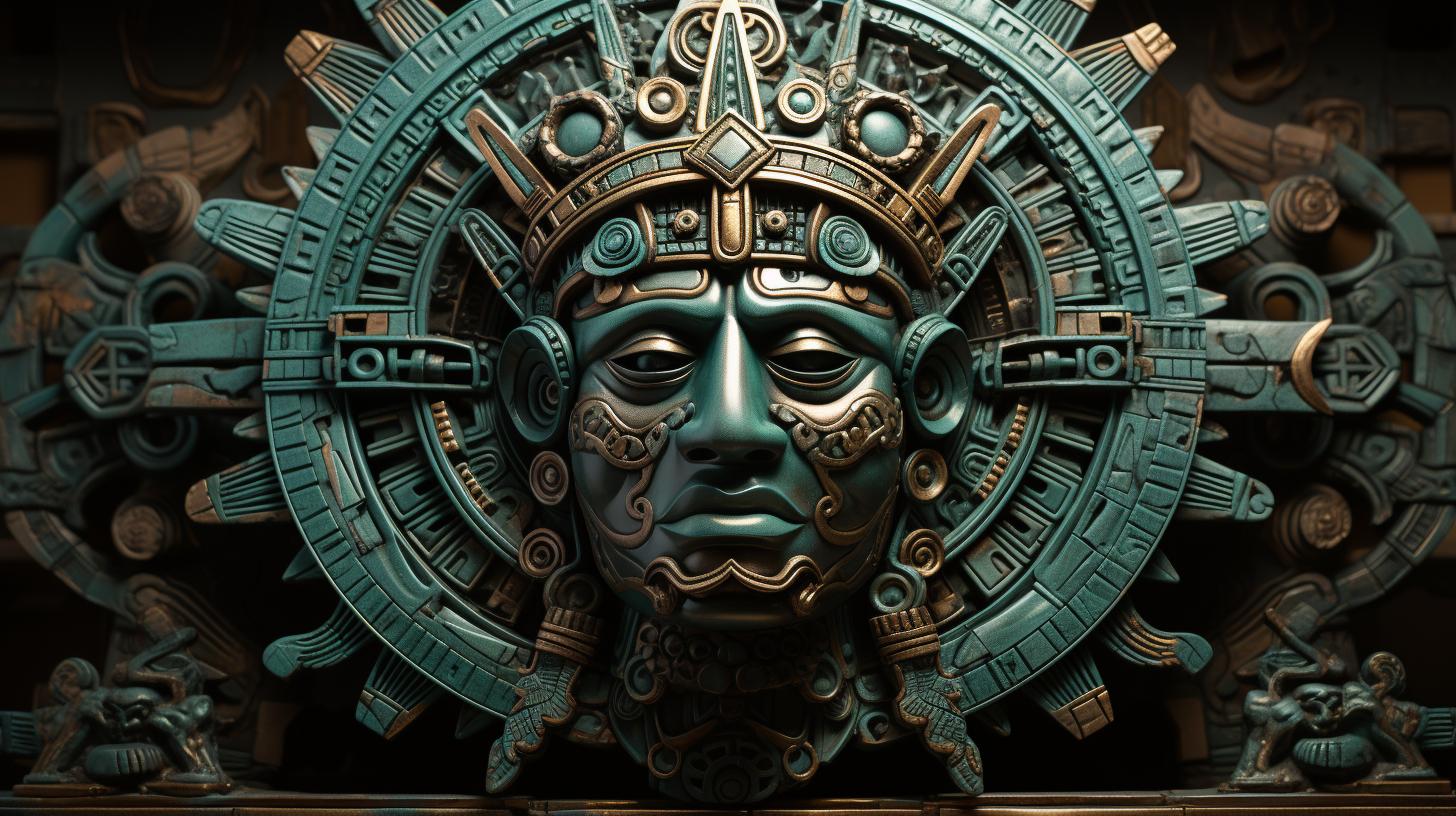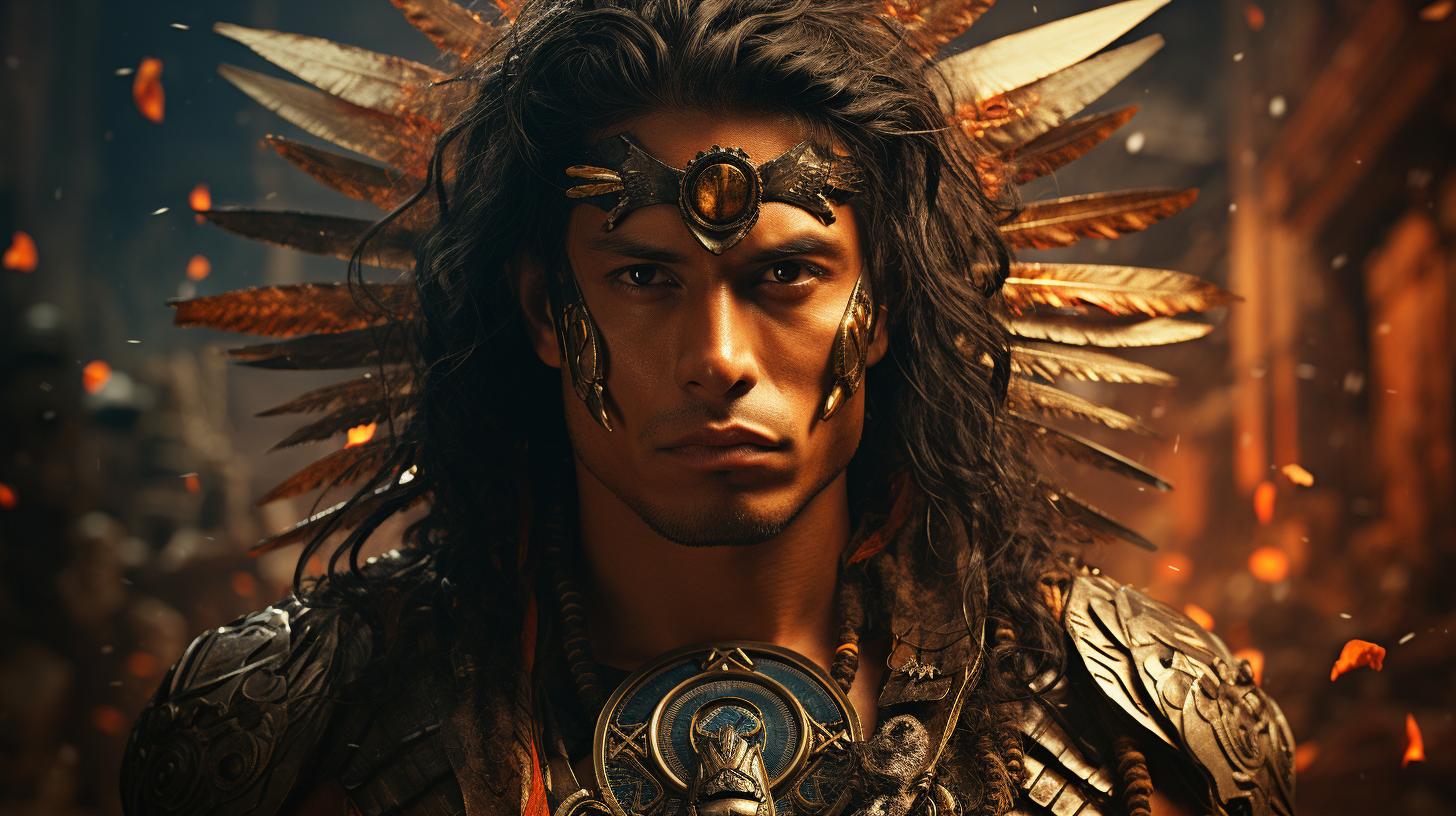Discovering the Aztec Deity Tonacatecuhtli: Insights into Creation, Fertility, and Sustenance
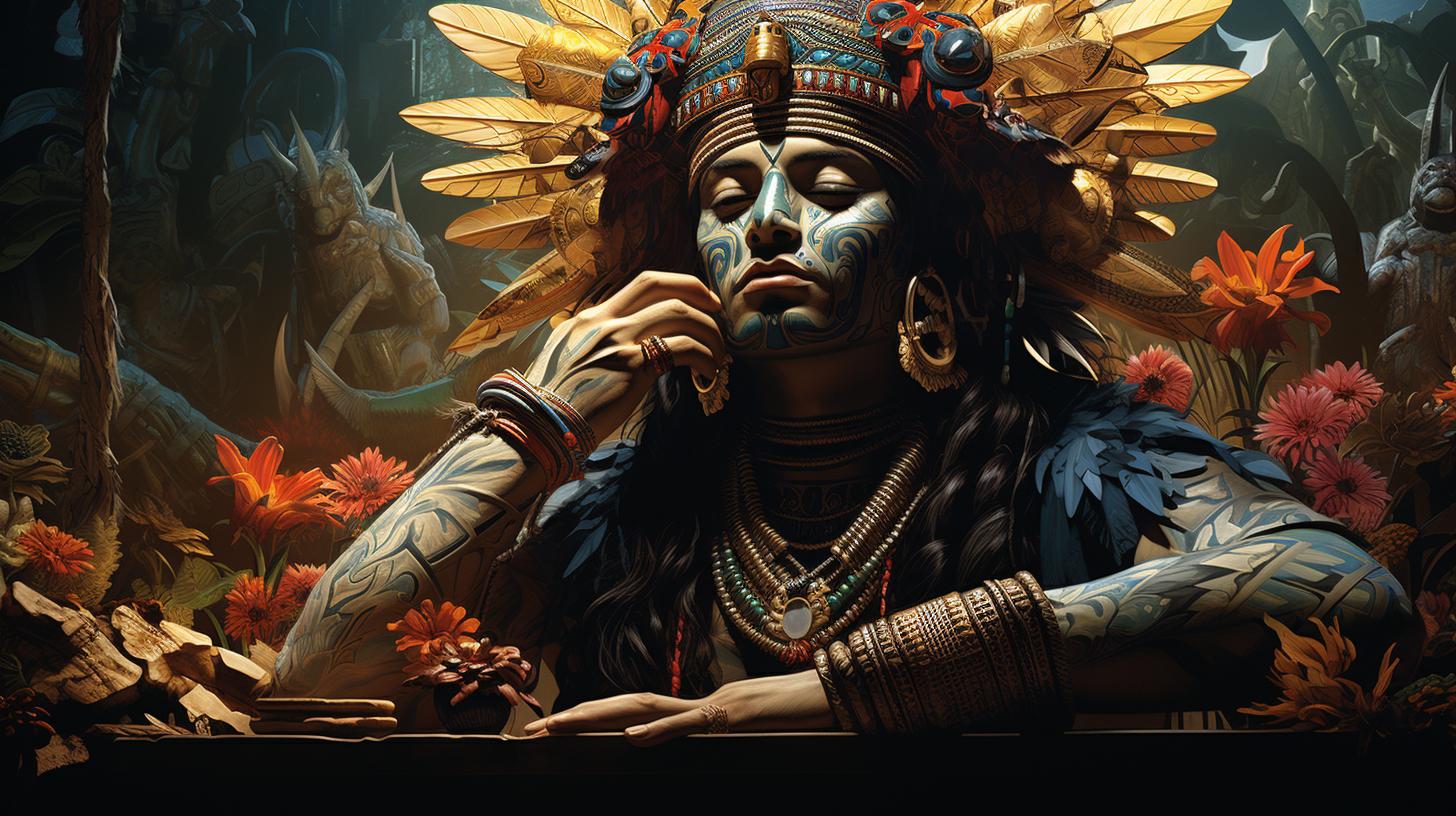
Tonacatecuhtli, the Aztec deity, is revered for its association with creation, fertility, and sustenance. Alongside Tonacacihuatl, they reside in the highest heaven called Omeyocan. Tonacatecuhtli represents the primal masculine principles, while Tonacacihuatl embodies the feminine aspects.
They hold significance in the Aztec calendar, with their day being Cipactli, symbolizing progress and honor. Tonacatecuhtli has notable offspring such as Tezcatlipoca, Quetzalcóatl, and possible connections to Tonatiuh, the sun god.
Their influence is demonstrated through punishments, such as Chantico’s transformation, and rewards, like Tezcatlipoca and Quetzalcóatl’s redemption. Tonacatecuhtli shows similarities to other Mesoamerican deities, like the Maya god of stars and fertility.
The Role of Tonacatecuhtli in Creation Mythology
Tonacatecuhtli, the Aztec deity, holds a significant role in Aztec creation mythology. This section delves into the various aspects of Tonacatecuhtli’s influence, starting with the creation of Ometecuhtli and Omecihuatl.
The Creation of Ometecuhtli and Omecihuatl
The mythological narrative attributes Tonacatecuhtli with the creation of Ometecuhtli and Omecihuatl, the primordial deities who served as the sources of all life.
It is through their existence that Tonacatecuhtli embodies the principles of creation and fertility.
Tonacatecuhtli’s Representation of Masculine and Feminine Principles
As a deity, Tonacatecuhtli symbolizes the essential masculine and feminine principles woven into the fabric of creation. Their presence encompasses both the masculine and feminine creative energies that shape the Aztec worldview.
Tonacatecuhtli’s Association with Ometeotl and Ometecuhtli
Tonacatecuhtli shares an association with Ometeotl, the Lord of Duality, and is often mistakenly equated with Ometecuhtli. While Ometeotl represents the concept of duality, Tonacatecuhtli represents the heavens, distinct from gods associated with the sun or fire.
Overall, Tonacatecuhtli’s presence in Aztec creation mythology is crucial, especially in their role as the creator of Ometecuhtli and Omecihuatl. Their representation of the masculine and feminine principles and association with Ometeotl further solidify their significance within the intricate belief system of the Aztecs.
Tonacatecuhtli and Tonacacihuatl in Omeyocan
Tonacatecuhtli and Tonacacihuatl reside in Omeyocan, the highest Aztec heaven. Omeyocan is a celestial realm of great significance, representing the pinnacle of the Aztec cosmology. It is believed to be a place of duality and harmony, where opposing forces coexist.
The High Heaven of Omeyocan
Omeyocan is the ultimate dwelling place for deities, representing the highest level of existence. It is often described as a celestial paradise, a realm where divinity thrives. In this transcendent space, Tonacatecuhtli and Tonacacihuatl hold their divine authority, overseeing the cosmic order.
The Dual Nature of Tonacatecuhtli and Tonacacihuatl
Tonacatecuhtli and Tonacacihuatl embody the principles of duality and balance. Together, they represent the harmonious interplay between masculine and feminine energies, essential for the maintenance of the cosmic order. Their presence in Omeyocan signifies the importance of equilibrium and unity in Aztec mythology and belief systems.
In Omeyocan, Tonacatecuhtli and Tonacacihuatl manifest their roles as primordial forces, upholding the foundations of creation, fertility, and sustenance. Their union symbolizes the dynamic interdependence necessary for the sustenance and preservation of life in the Aztec worldview.
Within the celestial realm of Omeyocan, Tonacatecuhtli and Tonacacihuatl radiate their divine influence, orchestrating the balance and fertility of the Aztec universe. As pivotal deities in the Aztec pantheon, their dual nature and divine authority remain integral to the understanding of Aztec cosmology and mythological narratives.
Tonacatecuhtli in Aztec Cosmology
Tonacatecuhtli occupies a prominent position in Aztec cosmology, representing essential aspects of the celestial realm. Through various depictions and associations, Tonacatecuhtli plays a significant role in the Aztec understanding of the universe.
Representations of Tonacatecuhtli as a Celestial Being
Tonacatecuhtli is often portrayed as a celestial being, draped in rich garments symbolizing light. Although mistakenly associated with sun or fire deities, Tonacatecuhtli is solely representative of the sky. As a central figure in the cosmos, Tonacatecuhtli serves as the focal point around which everything revolves, bringing balance to the universe.
Tonacatecuhtli’s Alleged Associations with Solar and Fire Deities
While Tonacatecuhtli is not directly associated with solar or fire deities, there have been misconceptions due to his celestial nature. These misattributions arise from the correlation between the sun’s position in the sky and Tonacatecuhtli’s central role in Aztec cosmology.
However, it’s crucial to note that Tonacatecuhtli’s significance lies solely in representing the heavens.
Tonacatecuhtli as the Symbol of the Sky
As the symbol of the sky, Tonacatecuhtli embodies the ethereal realm and its connection to creation and sustainability. Through his representation, the Aztecs sought to comprehend the cosmic order and the interplay between divine forces that governed their world.
Tonacatecuhtli’s presence underscores the fundamental importance of the celestial realm in their belief system.
Tonacatecuhtli’s Position in the Aztec Calendar
Tonacatecuhtli’s significance in the Aztec calendar cannot be overstated. As a deity associated with creation, fertility, and sustenance, Tonacatecuhtli held a central role in the celestial cycles that governed Aztec life.
The Significance of Tonacatecuhtli in the Aztec Calendar
Tonacatecuhtli occupied a prominent place in the Aztec cosmology, representing the balance and harmony of the universe. As the creator of the divine entities Ometecuhtli and Omecihuatl, Tonacatecuhtli’s presence permeated all aspects of Aztec mythology and ritual.
The Aztecs believed that Tonacatecuhtli’s influence extended beyond the spiritual realm and into their daily lives. They recognized the interconnectedness of the celestial and earthly realms through Tonacatecuhtli’s position as the axis upon which everything revolved.
The Day of Cipactli: Symbolism and Significance
Within the Aztec calendar, Tonacatecuhtli’s special day was Cipactli, which represented both the cocodrile and the concept of primordial chaos. This symbolic day held profound meaning, as it signified opportunities for new beginnings and endeavors.
- The Cocodrile Symbolism: Cipactli’s association with the cocodrile represented the primeval waters, symbolizing the potential for growth and transformation.
- Opportunities for New Enterprises: Aztecs believed that starting new projects on the day of Cipactli would bring prosperity and success, as it was aligned with Tonacatecuhtli’s creative power.
- Honor and Progress: Cipactli also symbolized honor and progress, providing a favorable time to undertake significant endeavors and achieve personal growth.
Awareness of Tonacatecuhtli’s presence in the Aztec calendar granted the ancient civilization a deeper understanding of their own existence and the cyclical nature of life.
Tonacatecuhtli’s Offspring and Depictions in Aztec Mythology
Within Aztec mythology, Tonacatecuhtli is revered as the creator and father of several significant deities. These divine offspring play crucial roles in the Aztec pantheon and have distinct characteristics and depictions.
Tezcatlipoca, Quetzalcóatl, and Other Divine Offspring
Tezcatlipoca, known as the “Smoking Mirror,” is one of Tonacatecuhtli’s prominent offspring. He is associated with night, sorcery, and destiny. Tezcatlipoca is often depicted with a black mirror on his chest and a smoking obsidian mirror for a foot, representing his connection with self-reflection and mystery.
Quetzalcóatl, the “Feathered Serpent,” is another significant deity born from Tonacatecuhtli. He represents wisdom, life, and fertility. Quetzalcóatl is often portrayed as a feathered snake, a symbol of his dual nature and connection to the celestial and earthly realms.
In addition to Tezcatlipoca and Quetzalcóatl, Tonacatecuhtli has other divine offspring who hold important roles within the Aztec pantheon. These include Huitzilopochtli, the god of war and the sun, and many others who specialize in various aspects of nature, culture, and celestial events.
Possible Connections with Tonatiuh, the Sun God
There are intriguing suggestions of a connection between Tonacatecuhtli and Tonatiuh, the Aztec sun god. While their precise relationship is debated among scholars, some propose that Tonatiuh may be an aspect or manifestation of Tonacatecuhtli.
Tonatiuh is commonly depicted as a warrior with a radiant solar disc on his head, representing his association with the sun and vital life force. He plays a central role in Aztec cosmology and rituals, symbolizing the continuous cycle of creation and destruction.
- The divine offspring of Tonacatecuhtli, such as Tezcatlipoca and Quetzalcóatl, hold significant positions in Aztec mythology.
- Tezcatlipoca embodies the mystery and reflection of the divine, while Quetzalcóatl represents wisdom and fertility.
- Tonacatecuhtli’s connection with Tonatiuh, the sun god, suggests a deeper relationship between these two deities.
- Tonatiuh symbolizes the eternal cycle of creation and destruction and is associated with the vital life force of the sun.
Through their unique depictions and roles in Aztec mythology, Tonacatecuhtli’s divine offspring demonstrate the complexity and diversity of the Aztec pantheon, enriching the tapestry of their cosmological beliefs.
Tonacatecuhtli’s Actions and Influence in Aztec Mythology
Within Aztec mythology, Tonacatecuhtli holds significant power and authority, exerting judgment through punishments and rewards. His actions shape the course of events and reflect his role as a divine arbiter.
Punishments and Rewards: Tonacatecuhtli’s Judgments
Tonacatecuhtli, as the overseer of creation, bestows punishments upon those who violate the divine order and rewards those who uphold it faithfully.
His judgments serve as lessons and reminders of the consequences of actions.
As the Aztec mythological narrative unfolds, Tonacatecuhtli’s punishments and rewards act as a moral compass, reinforcing the importance of obedience and reverence for the gods.
Chantico’s Transformation: A Divine Punishment
One striking example of Tonacatecuhtli’s punitive actions is the case of Chantico, the first woman to break the rule of fasting before making an offering to the gods. In response to her transgression, Tonacatecuhtli transformed her into a dog as a severe punishment.
This transformation stands as a cautionary tale, showcasing Tonacatecuhtli’s unwavering commitment to justice and the consequences that follow the defiance of divine laws.
Tezcatlipoca and Quetzalcóatl’s Redemption: The Restoration of Creation
Despite his role in delivering punishments, Tonacatecuhtli also demonstrates benevolence by offering redemption and the possibility of restoration.
Two key deities, Tezcatlipoca and Quetzalcóatl, engaged in destructive behaviors that threatened the balance of creation.
To rectify their actions, Tonacatecuhtli bestowed his blessings upon them, allowing their transformation into two towering trees, symbolizing the restoration of harmony and the renewal of the world.
This act of redemption showcases Tonacatecuhtli’s ability to recognize change and offer opportunities for growth and reconciliation.
Overall, Tonacatecuhtli’s actions and influence in Aztec mythology highlight his role as a powerful and just deity, ensuring the order and balance of the cosmos through his discernment in punishments and rewards.
Tonacatecuhtli in Comparison to Other Mesoamerican Deities
Tonacatecuhtli in Maya Mythology: Connections and Differences
Tonacatecuhtli, the Aztec deity, shares intriguing parallels with deities in Maya mythology. While revered as the god of creation, fertility, and sustenance among the Aztecs, Tonacatecuhtli holds a distinct place in Maya cosmology.
In Maya mythology, Tonacatecuhtli is depicted as the god of stars and fertility, responsible for bringing light and life to the world. Paired with the goddess Ixchel, it is believed that they collaborated in the creation of the world and its inhabitants.
Similarities to other Mesoamerican Gods and Goddesses
Tonacatecuhtli’s influence extends beyond Aztec and Maya mythology, as he shares significant similarities with gods and goddesses from other Mesoamerican cultures. In the ancient Zapotec civilization, a deity known as Cosijoeza bears resemblances to Tonacatecuhtli, embodying similar themes of creation, sustenance, and cosmic balance.
Furthermore, in Nahua mythology, Tonacatecuhtli shares commonalities with Tlaloc, the rain god. Both deities hold roles related to fertility and nourishment, emphasizing their fundamental importance in Mesoamerican belief systems.
- Both beings hold roles related to creation, fertility, and sustenance
- They are associated with cosmic balance and the dual nature of existence
- Similar attributes and symbols are attributed to both deities
- They have direct connections to other prominent deities in their respective pantheons
These striking similarities suggest a shared cultural foundation and the intertwining of religious beliefs among Mesoamerican civilizations.
.

